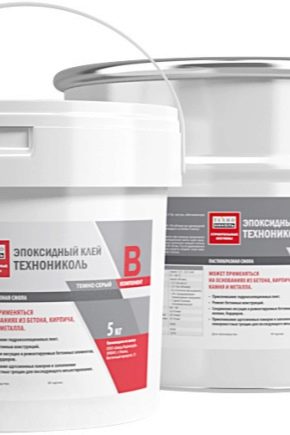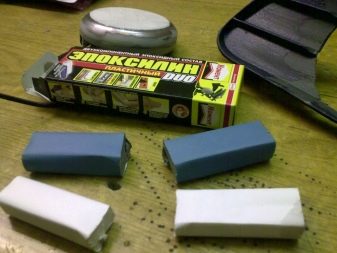How to dilute epoxy glue?

To achieve a strong connection of parts, glue is often used. Epoxy glue is suitable for different jobs, as it is affordable and easy to use, and also provides a reliable connection of solid surfaces.
What it is?
Epoxy glue is a synthetic product based on epoxy resin. The French chemist Castan received epoxy resin in 1936. This fact gave impetus to the development of the chemical industry. The fact is that by adding various substances to the resin, many new materials can be obtained. On the basis of epoxy resins produce adhesives and casting compounds, plastics, varnishes and many other products for various industries.
Physically, the resin can be a thick, viscous liquid, clear white, yellow and dark red in color, or a solid brown mass. Substance is characterized by resistance to halogens, some acids and alkalis. To obtain the adhesive composition, various components are added to it: hardeners, solvents, fillers and plasticizers.
Epoxy resin is often used as a household glue, which is easy to prepare and use. For the preparation of epoxy mix small amounts of resin and hardener. Room temperature is an appropriate condition. The proportions for mixing are specified by the manufacturer.
Kinds
To the main characteristics by which epoxy glue is classified, belong to the following:
- composition;
- consistency;
- curing method.
In composition, it can be of two types.
- In the composition of the one-component adhesive is used liquid resin or resin with a solvent. The product is packaged in tubes and is ready for use without preparation. It is used for gluing small parts or sealing gaps.
- Most often, epoxy glue is a two-component.It is sold in a kit, which includes two tubes. One tube contains the resin in a paste-like form, the second - the hardener in the form of a liquid or powder. The contents of the two tubes are mixed, and immediately applied, because after some time the mixture loses its ability to glue. Most manufacturers produce exactly two-component glue. Its use is almost universal.
The consistency of glue is of two kinds.
- Liquid glue has the form of a gel. It saves time, because it does not need to be prepared, and is also convenient for applying to the surface.
- Plastic mass will have to prepare. To do this, cut off the right amount from the contents of the cylindrical tube or bar, knead it with your hands and moisten with water. Plastic mass is great for repairing chips, dimples, and other defects.
The curing method divides the adhesives into the following varieties:
- in the first, curing occurs at room temperature;
- the second must be heated before the introduction of the hardener.
How to mix at home?
To mix the glue at home, you need to prepare for the process.It is recommended to carry out work in a well-ventilated room - inhalation of epoxy resin vapors is unlikely to benefit the body. Wear a respirator. For work it is necessary to use protective gloves. You should wear old clothes and cover the workplace with something - it will be extremely difficult to clean off the glue caught on them.
The surfaces to be glued should be pre-treated, as the solution must be applied very quickly after mixing. And also in advance it is necessary to prepare the tools with which to apply glue, and the dishes for the preparation of the mixture. It should be clean and dry. Starting mixing, you should carefully study the instructions from the manufacturer.
How to cook?
It is necessary to measure the ingredients in the required quantities. At home, it is very convenient to do this in medical syringes, as they have dimensional divisions. In addition, the syringe will allow you to carry out the procedure carefully and take in the right dosage, even small amounts of substances. It is not necessary to insert a needle into the syringe. The resin and hardener should be collected in separate syringes and placed in different containers.If the resin is too thick, then it can be poured into the syringe from above, having first removed the piston and closed the spout. Then both substances are thoroughly mixed to obtain a homogeneous mass.
Each mass is also mixed with a separate instrument. Epoxy resin is difficult to mix due to its high viscosity. To facilitate the process, it is heated using a water bath. The heated resin is mixed more easily, but the temperature should not be higher than + 55–60 ° C, since the polymerization process will accelerate. Also, you should carefully monitor that water does not fall into the resin.
After this mass is combined. To get the glue, the resin must be diluted with a hardener. It is not necessary to plant very quickly, because too active movements will lead to the formation of bubbles in the glue. They do not hurt much if you need a composition for bonding. But epoxy is often used to create decorative items, then bubbles will spoil its appearance.
Ratios of the ratio
To get the composition of good quality, you must use the correct proportions of ingredients. Manufacturers, as a rule, they are indicated in the instructions for use.Most often, this ratio is 10 parts of resin to 1–1.3 parts of hardener. For some resins, other proportions may be indicated. The instructions should be followed literally. It happens that the instruction is not registered or lost. In these cases, take 10 parts of the resin and 1 part of the hardener.
If there is no confidence in the correct ratio of ingredients, the composition can be checked. You should take a little cooked mixture with a hardener and place in a small metal container, and then gently heat it, but do not bring it to a boil. When the substance has cooled, you can determine its quality. If the cooled mixture hardened, then everything is done correctly and glue can be used. If the mixture remains viscous, there is not enough hardener in it.
How to dilute?
Cooked epoxy glue remains liquid for a very short time. It can vary from 15 minutes to half an hour (depending on the manufacturer), and then quickly thickens and hardens. Sometimes this time is not enough to do the work. To extend the time of work with glue, it can be diluted with acetone. It does not need much - you need to take one part of it in relation to the amount of resin and gently stir.
Glue will retain a liquid consistency up to 1 hour.After being applied to the surface during the drying process, the acetone will evaporate and the epoxy will retain its properties. Do not exceed the amount of acetone, as the strength deteriorates.
How to make more liquid?
For some surfaces, the use of viscous glue is not always convenient. Sometimes you need a liquid composition to soak the materials. In order to make the epoxy mixture more elastic and pliable to the application, it can be made more liquid.
There are two ways to do this.
- Heating retains the properties of the adhesive, but reduces the time to work with it. In addition, you can inadvertently exceed the heating temperature, then the glue will be damaged. In this case, it is advisable to heat the glued surfaces when possible. Advantages will be the preservation of the life of the glue and its easier application.
- Add solvent. For a more liquid composition, it can be mixed not only with acetone, but also with solvent-based lacquers, denatured with alcohol. Increasing the life of the epoxy, they can change its color and damage the surface. Shrinkage of the resin and reduction of its strength can also occur.
How to achieve a transparent color?
Sometimes the color of the adhesive is important.In some cases, you need a transparent composition to hide the traces of repair, for example, jewelry. Such a composition may be needed when creating decorative items. Modern industry offers a wide range of epoxy compositions and dyes for them. With their help, you can achieve different colors, their shades and effects: any one-color, matte, fluorescent, mother-of-pearl, with sparkles.
Preparing them is easy: you need to add 5-6% paint in relation to the amount of resin in the composition. The same tools will make the resin transparent if dissolved to 0.05% of the product. As an improvised means, you can use the ink of a ballpoint pen or gel pen, alkyd paints. Air bubbles have an influence on transparency, so you should gently mix the composition. You can put it in a water bath, because heating will contribute to the release of bubbles.
Recommendations for use
To epoxy glue well bonded surface, you need to use it properly, namely:
- Although epoxy is a universal remedy and is suitable for different materials, it is not suitable for polyethylene, nylon, polystyrene,plexiglass and smooth non-porous materials;
- repaired surfaces must be free from dust and dirt, degreased and dried;
- glue preparation should be carried out strictly according to the instructions with respect for the proportions of the ingredients; it is not necessary to prepare the composition in large quantities;
- glue is applied to all surfaces that will stick together; After applying the adhesive, it is very important to press the surfaces together tightly;
- after gluing, the product can be used not earlier than in a day, when the composition polymerization ends.
Useful tips from the pros
It will not be superfluous to follow such professional advice as:
- use personal protective equipment when working with glue;
- in the preparation of the composition to prevent ingress of water into it;
- do not add hardener in large quantities, as this will cause a quick chemical reaction and hardening of the resin;
- immediately verify the correctness of the combination of parts.
In the next video you will find the secret dosage of epoxy resin.















































